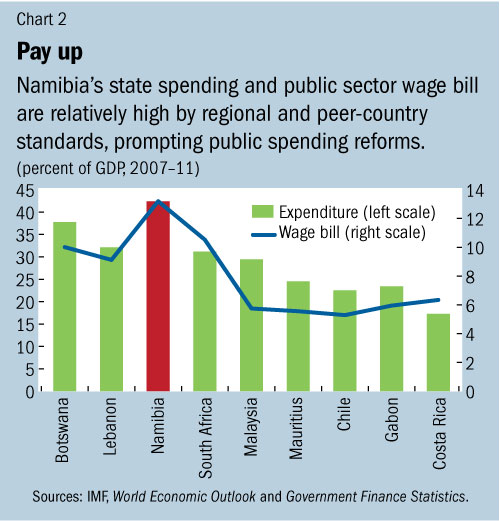
Typical street scene in Santa Ana, El Salvador. (Photo: iStock)
IMF Survey : Minerals Demand Shields Namibia from World Trade Slowdown
February 22, 2013
- Namibian economy bounced back strongly from 2008–09 global financial crisis
- Growth is forecast to be firm in 2013 amidst fragile global economy
- Major steps taken to ease infrastructure bottlenecks, enhance job creation
Demand for mineral exports drove Namibia’s strong recovery last year from the effects of the world economic crisis.

Diamond mine in Namibia, where 2012 economic recovery was supported by strong rebound in primary sector (photo: Anthony Bannister/Gallo Images/Corbis)
ECONOMIC HEALTH CHECK
But, IMF economists said in their regular review of the southern African nation’s economy, Namibia’s recovery could be hampered by the impact on trade flows of renewed global uncertainty. Further slowdowns in key markets could hit Namibia’s relatively open economy by cutting demand for exports and reducing tax revenues.
The Namibian economy bounced back strongly from the 2008–09 global financial crisis but growth moderated in 2011 due to weaker mineral exports (see Chart 1). During the first half of 2012 economic recovery in Namibia was supported by a strong rebound of the primary sector, most notably minerals such as diamonds and uranium.

Amid a fragile global economic environment, Namibia’s real GDP growth is projected to moderate to 4 percent in 2012 from about 5 percent in 2011. The uncertain external environment poses downside risks to export demand and therefore the underlying fiscal position.
Trade linkages
Further deterioration of the euro area economies may generate significant negative spillovers to the Namibian economy through trade linkages, as a large share of Namibia’s total exports—mainly uranium ore, diamonds, beef, unrefined copper, and fish—are destined for Europe.
Namibia’s growth prospects are further clouded by socioeconomic factors, including high unemployment, poverty, and inequality. These issues require a response based on creating stronger domestic engines of more inclusive economic growth.
In their review, IMF staff focused on five key issues.
â— Rebuilding fiscal policy buffers and ensuring external sustainability. The government launched a major three-year fiscal initiative in FY2011/12 to ease infrastructure bottlenecks and enhance job creation. The authorities should unwind the current fiscal expansion as planned in order to preserve fiscal and external sustainability and create room to smooth shocks.
â— Managing inward global spillovers. Current global spillovers might lead to a decline in mineral exports and thus a significant loss in fiscal revenues. In the event of further adverse global shocks, staff advised the authorities to allow automatic stabilizers to work on the revenue side—by letting cyclical changes make fiscal policy automatically expansionary during downturns—as long as the public debt is not above the target of 35 percent of GDP.
â— Reinforcing financial stability. Commercial banks, mostly subsidiaries of South African banks, are well capitalized and profitable, with little direct exposure to the financial turmoil in Europe. Increased vigilance is, however, needed to monitor potential vulnerabilities stemming from a sizeable concentration of banks’ lending to mortgages, residential property price buildup, and growing household indebtedness. In this respect, IMF staff commended the Bank of Namibia for recent macroprudential measures taken to strengthen financial stability.
â— Promoting inclusive growth and reducing unemployment. Addressing Namibia’s income inequality and persistently high structural unemployment will require reforms in public sector employment and wage policies. Alignment of the curricula for university education, tertiary education, and vocational training would help meet the demand for skilled labor in the broader economy.
â— Fostering institutional and capacity development in support of stronger growth. Strengthening public expenditure management, procurement, and financial accountability will enhance institutional capacity that is also crucial to support long-term growth.
State spending reforms
Namibia’s state spending and public sector wage bill are relatively high by regional and peer-country standards (see Chart 2). The authorities broadly concurred with IMF staff on the need to rein in current expenditures and address unproductive spending.

Staff endorsed government measures to address the state of finances of state-owned enterprises and emphasized the need for a speedy implementation of the authorities’ reform agenda to improve the efficiency and financial viability of the state-owned business sector.
IMF staff also stated in their review that to improve competitiveness and fiscal sustainability, the authorities should articulate bold measures to achieve wage restraint. They added that reforms to broaden the tax base should be done in a manner that enhances the predictability and simplicity of the tax system.
Given the negative impact of income inequalities on growth, the IMF review recommended policies to target inequality at the source including fostering targeted investment in health and education. The review also supported ongoing measures to promote greater financial inclusion, by encouraging financial access for a broader part of the population while limiting associated regulatory risks, including on money laundering consistent with the authorities’ 2011–2021 Financial Sector Strategy Plan.







